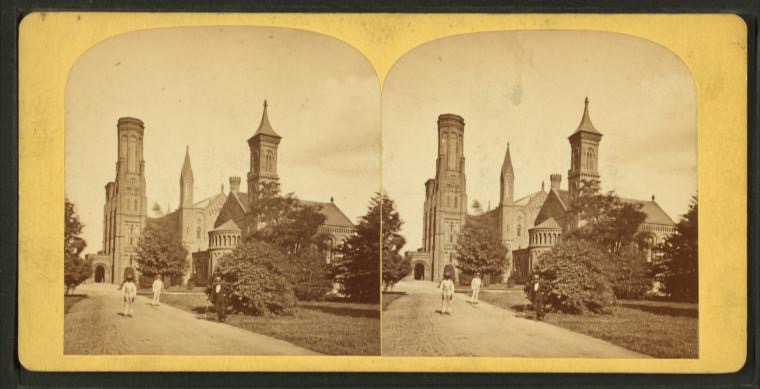Tourististan

C. M. Bell: Smithsonian Institute.[still image Stereograph} (1870-79)
" … charge nothing for admission but leave a much more lasting impression."
Neither The Muse nor I had ever lived in such proximity to famous places until we were Exiled to our nation's capital. There, a National Mall holds a collection of monuments and museums that contain something akin to our national heritage. Millions of visitors travel long distances to visit these places. It's a tradition that if you're about to graduate from a high school located anywhere along the Eastern Seaboard, your class will travel by bus to what The Muse and I came to call Tourististan. On any odd summer afternoon, tour busses line The Mall from Fifteenth Street to the foot of Capitol Hill, idling, belching diesel smoke. They disgorge their passengers into swirling crowds of the usual suspects: boys showing off to imaginary girlfriends and preening teen females carrying identical non-functional purses. Add to the mix families pushing strollers filled with kids too young to appreciate anything they might witness. Welcome to Tourististan.
We gave The Mall wagon room and usually went out of our way to avoid the place. Aside from the National Indian Museum cafeteria and a few poorly placed food carts, it's a food desert. On a typical August afternoon, it's equatorially hot, humid, and ungodly dusty. The Metro stations overfloweth with shattering dreams, fathers pushing sunburned toddlers in strollers vying for limited space on their way back to their hotels and desperately needed cold beers. There's something in the American psyche, I suspect, that draws us into personally inspecting the icons of our civilization. We feel driven toward the Smithsonian Air and Space Museum to stand next to Wilbur and Orville Wright's grand experiment. We seem to need to stand inside a mock-up of a moon lander and peer in fascination at an actual moon rock encased in plexiglass. These icons represent our nation's stations of the cross, and it's a religious experience to join the throng and jostle ourselves into becoming witnesses.
I sometimes rode my bike down to The Mall and watched from a distance, curious. My graduating high school class didn't go on any class trip. Washington, DC, seemed so distant that it was more like a dream than an actual place, a Disneyland for patriots. I never suspected that I might one day live in such proximity, let alone find any reason to use those institutions' research libraries for business rather than entertainment. I quickly became a local rather than a visitor. In the first few months, I visited those museums. That done, I rarely felt any compulsion to return. I might sit on a plain park bench next to a bubbling fountain in the underappreciated Smithsonian Castle's gardens, which were filled with unusual plants and every plant labeled, while the tourists raced between the National History and American History Museums just across The Mall.
Locals frequent spots off the tourist agenda. A little park across Independence Avenue from the National Botanical Museum sits slightly off the usual tourist path. This park features a lovely pergola and fine teak rockers. I'd walk there after studying at The Library of Congress, passing down through the trees on the southern side of the Capitol Complex to sit in the shade and listen to a bubbling fountain built during Teddy Roosevelt's administration, which was still in perfect working order. Traffic streamed by, oblivious to one of the finest examples of gentility. I could quietly meditate or go over my study notes in nearly perfect isolation there, a scant couple of blocks from teeming Tourististan.
There are dozens of such places few tourists ever stumble upon. Their attention seems distracted from more representative experiences, for it seemed that being an American was more like sitting in a pergola than elbowing my way through crowds. When visiting New York, I used to join the throngs, too. After many visits, though, I found myself gravitating toward more pedestrian places. Just walking the streets seems more authentically present than waiting in any hundred lines to ride the elevator to the top of another Empire State Building. I ache to experience such places as a local might rather than as a tourist because tourists always bring their experience with them by trying to fulfill their expectations rather than just trying to inhabit a different place for a second. Tourists crowd themselves into clusters that behave the same, whether at the Statue of Liberty or Independence Hall. They travel far to end up precisely where they always were. They seem to seek to satisfy their naive expectations rather than trying to surprise themselves. The pergola parks in life charge nothing for admission but leave a much more lasting impression.
©2024 by David A. Schmaltz - all rights reserved


